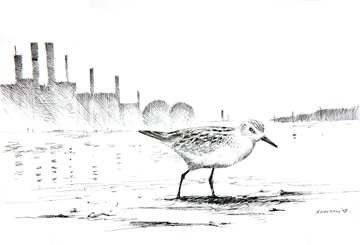Little Stint (Calidris minuta)

Little Stint © Ray Scally
Little Stint is one of several waders that mainly occur here on autumn passage, especially when easterly winds blow inexperienced young birds off-course, with appearances in winter and spring becoming more common in recent years. They breed on the high Arctic tundra from northern Sweden eastwards across Russia, with most of the population in Siberia, and one million or more winter in trans-Saharan Africa, with perhaps 10,000 in Europe, mostly in the Mediterranean Basin (Birdlife International 2004). Britain is at the extreme northern edge of the wintering range, and there were fewer than thirty wintering in Britain and Ireland during the early 1980s (BTO Winter Atlas). Numbers have increased to an estimated 100-400 in Ireland during the late 1990s but still so few in Britain that they were not listed in the pan-European collation (Birdlife International 2004).
The Atlas map shows a reasonable reflection of the species’ status in Cheshire and Wirral, although the aggregation of three winters exaggerates the picture somewhat. Five of the seven Atlas dots come from single birds, with two birds on Frodsham Marsh no.6 bed (SJ47Y) on 7 January 2006, and a flock of at least twelve birds on the northern part of the same site (SJ47Z) in 2006/ 07. Frodsham Marsh and the adjacent River Mersey has been the favourite site for Little Stints in winter in the county for at least the last thirty-five years, with Inner Marsh Farm (SJ37B) and the Sandbach Flashes (SJ75J) the next most likely to be visited.
Apparently the first winter record in the present recording area was at Frodsham Marsh on 28 November 1954 (Bell 1962), followed by one at Burton in December 1957. The county’s third wintering Little Stint was ringed at New Ferry (SJ38M) on 31 December 1958 and found in Friesland, the Netherlands, on 9 April 1959, giving interesting information on the timing and route of return towards the breeding grounds. Bell (1967) knew of wintering birds in each year since 1961, including five remaining to 25 November 1962 at Sandbach Flashes. Since then, the annual bird reports show Little Stints present in the county in almost every winter since 1972/ 73. In some winters sightings have been only occasional and numbers small, while in others birds have been present throughout. Frodsham Marsh is the favoured winter site with overall monthly maxima of 30 in December, 25 in January and 26 in February, with these peak counts all in the period 1998/ 99 to 2001/ 02. Higher numbers wintering tend to follow the largest influxes in autumn, usually September, and that in September 1998 was the largest on record (Brown & Grice 2005). As well as being Cheshire’s main site for the species in winter, during 1981/ 82 to 1983/ 84, the 10-km square including Frodsham Marsh was one of only five in Britain to have held more than three birds (BTO Winter Atlas).
Little Stints feed mostly by picking insects and crustaceans from the surface, rather than probing into mud, and probably cannot cope well with freezing weather. The warming climate presumably accounts for the increased numbers wintering here, although they are but a tiny proportion of the species’ population.
Sponsored by Keith A Leggett

